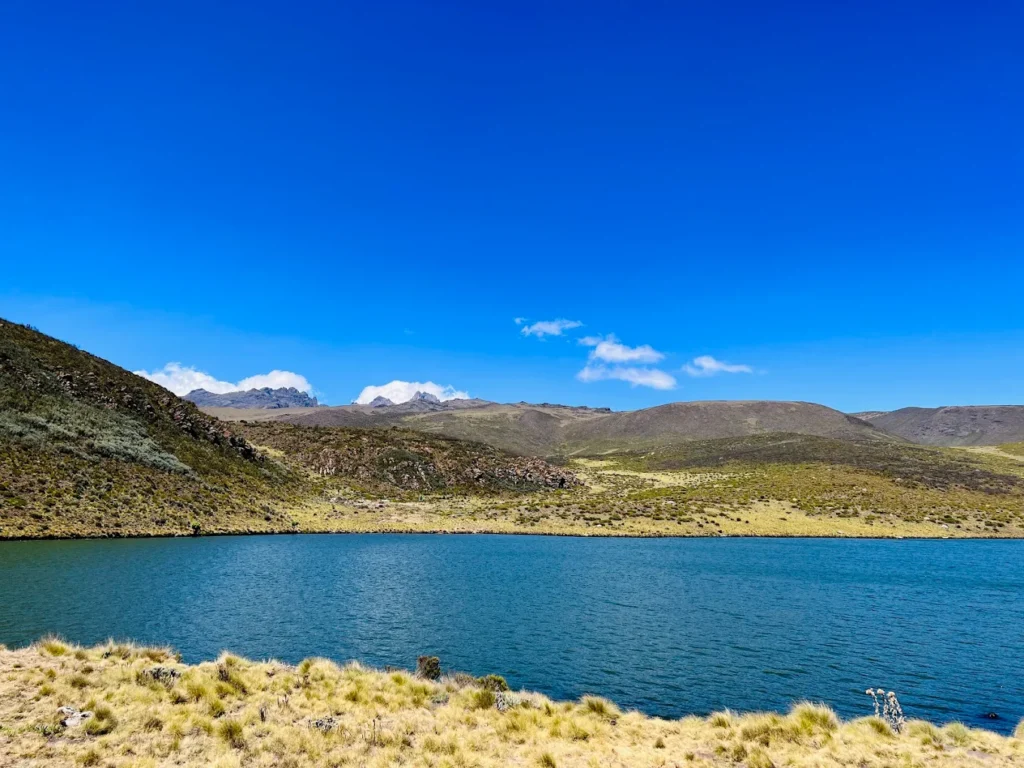The Fascinating History Behind Mount Kenya’s Camps and Lakes
Mount Kenya, Africa’s second-highest peak standing at 5,199m above sea level, it is more than a hiker’s haven—it’s a beauty to behold adored by both the local communities and foreigner who come from all over the worlds. Whether you’re planning a trek or simply curious about this majestic mountain, join us as we uncover the origins of Mount Kenya’s most iconic camps and lakes.

Caption: Mount Kenya’s breathtaking landscape.
A Mountain of Many Names
Before diving into Mount Kenya camps and Lakes, it’s worth noting Mount Kenya’s own naming history. To the Kikuyu, who live on its southern and western slopes, the mountain is Kirinyaga or Kilimambogo, meaning “the place of light” or “mountain of whiteness,” reflecting its snow-capped peaks. The Kamba people call it Kinyaa, while the Maasai know it as Ol Donyo Eiger, the “speckled mountain.” The name “Kenya” itself, adopted by European explorers, likely derives from Kinyaa or Kirinyaga, though its exact origins remain debated.
Camps: Rest Stops while hiking
Mount Kenya’s camps, scattered along its three main routes—Naro Moru, Sirimon, and Chogoria—are vital rest points for climbers tackling peaks like Batian, Nelion, or Point Lenana.
Mackinder’s Camp (Naro Moru Route, 4,200m)
Named after Sir Halford John Mackinder, a British geographer and mountaineer, this camp honors the leader of the first confirmed ascent of Batian in 1899. Mackinder, alongside Swiss guides Josef Brocherel and César Ollier, braved uncharted terrain to reach the summit, they ascended Nelion as far as south ridge and traversed the Diamond Glacier then Batian via the Gate of Mist . Perched in the Teleki Valley, Mackinder’s Camp offers stunning views of the peaks and gradual ascent .
Mackinder’s camp is managed by Naro Moru River Lodge
Shipton’s Camp (Sirimon Route, 4,200m)
Eric Shipton, a British mountaineer, In 1929, Shipton and Percy Wyn Harris made the first ascent of Nelion, Mount Kenya’s second-highest peak, what is now referred to as the normal route. Shipton later came back in 1930, he together with Bill Tilman completed the traverse and descended via the Nelion Route. Known for its gradual ascent and running streams, Shipton’s Camp is a favorite among trekkers.
Shipton’s hut is managed by Mountain Rock Hotel

Caption: Shipton’s Camp, second stop on the Sirimon route.
Austrian Hut (Near Lewis Glacier, 4,790m)
Situated near the Lewis Glacier and Point Lenana, the Austrian Hut is the highest shelter for trekkers. Its name stems from an incident that occurred when an Austrian climber, Judmeier fell when descending, he lay crippled while other mountaineers tried to reach him, they endured very bad weather and for seven days, they relentlessly searched for him.
To appreciate the sacrifices and the risks taken by the other climbers, the Austrian Government funded and trained the first mountain rescue team in Mount Kenya, this was in 1970, at 4,790m, Austrian hut serves as the starting point of the Normal Route to Nelion and a stopover for hikers summiting from the Mackinder’s hut.
Austrian hut is managed by Mount Kenya National Parks
Minto’s Hut (Chogoria Route, 4,290m)
On the scenic Chogoria route, Minto’s Hut is a small shelter near the Hall Tarns offering stunning views of the peaks. Its name, came from a member of the Austrian Mountaineering community, they contributed in building the huts in Mount Kenya, who passed away in 1968 attempting to climb, it serves as a shelter to mostly the mountain crew.
Liki North Hut (Sirimon Route, 3,900m)
Tucked in the Liki North Valley, this basic shelter takes its name from the surrounding geography(The hut is no longer there as of when this article is being written(May 2025) but the campsite is still there. The campsite is part of the broader Mount Kenya National Park, which is known for its pristine wilderness, lakes, glaciers, and diverse geological features.
American Camp (Western Peak Circuit)
Located near Nanyuki Tarn, American Camp’s name describes a popular, often high-altitude, camping area on the route to the summit, it is not an official name. Its lakeside setting makes it a picturesque rest point for those circling the peaks.
Lakes and Tarns: Jewels of the Mountain
Mount Kenya’s lakes and tarns, carved by ancient glaciers, dot the alpine zone between 3,950 and 4,800 meters.
Lake Michaelson (Gorges Valley, 4,000m)
Named by Halford Mackinder in 1899 for a friend who joined his expedition, Lake Michaelson is a 30-acre gem in the Gorges Valley. Known for its trout, introduced by early settlers like Raymond Hook, the lake is a serene stop above Vivienne Falls. Lake Michaelson is the second largest lake in the mountain after Lake Alice(48 acres)
Lake Ellis (Mugi Hill, 3,500m)
This 28-acre lake and the third largest after Michaelson and Alice, nestled at the base of Mugi Hill, was named after Thomas Evelyn Scott-Ellis, who was the first European who reached it in 1927 with Eric Dutton. A highlight of the Chogoria route, Lake Ellis is both a scenic and a great fishing spot.

Lake Alice (Gorges Valley, 4,300m)
The largest lake on Mount Kenya at 48 acres, Lake Alice was named for the Duchess of Gloucester, who visited Kenya and attempted a climb in 1934, she did not manage due to bad weather. Renowned for sport fishing, the lake is a vibrant ecosystem.
Hall Tarns (Chogoria Route, 4,300m)
These glistening tarns, near Minto’s Hut, were named after F.G. Hall, a District Commissioner at Fort Hall (now Murang’a) Mackinder named it. Their sparkling waters and alpine setting make them a Chogoria highlight.
Teleki Tarn (Teleki Valley, 4,300m)
Named for Count Samuel Teleki, a Hungarian explorer who led the first European expedition to explore Mount Kenya’s forest zone in 1887, this 8.5-acre tarn lies near Shipton’s Peak.
There have been calls to rename the Mountain huts and lakes from Europeans names to local ones to honor local figures or restore pre-colonial names.
As visitors, we can respect this heritage by learning about indigenous perspectives, supporting local guides, and advocating for inclusive naming. The Mountain Club of Kenya and local communities are great resources for deeper insights into these efforts on Mount Kenya camps and Lakes.
Plan Your Mount Kenya Adventure
Mount Kenya hiking is available year-round, the camps and lakes offer an unforgettable journey. Each stop carries a story that enriches the climb.
Be sure to:
- Choose Your Route: Naro Moru from the West, fastest route , Sirimon from the North for views, gradual ascent and best acclimatization or Chogoria from the East for lakes and tarns, also the most scenic other route are Timau, Kamweti and Burguret they are discussed here.
- Hire Local Guides: They bring expertise and cultural knowledge, choose an ethical mountain guide/ Operator and support the people and the country that make the memorable hike possible ensuring a safe and meaningful trek.
- Respect the Mountain: Follow Leave No Trace principles to preserve its beauty.
Have you trekked Mount Kenya or visited its lakes? Share your experiences in the comments below, or tell us which Mount Kenya camps and Lakes intrigues you most! For more travel tips and history, subscribe to our newsletter and follow us on our socials.




